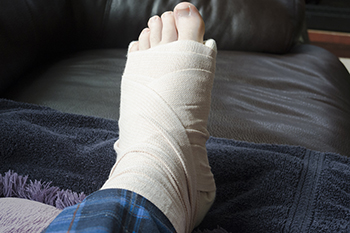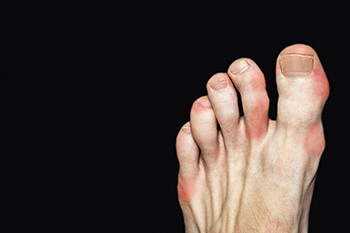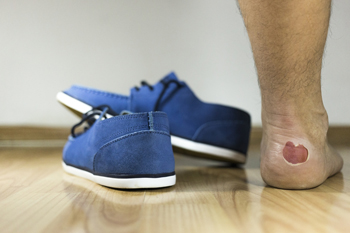Glen Allen Office
(804) 747-3380

The foot withstands considerable force placed on it by all the activities we do, including walking. There are 26 bones in the foot that are connected by joints and supported by ligaments to absorb the impact of movement. Also, muscles and tendons in the foot allow for flexing and extending the foot. Bones in the foot can break from direct blows, injuries, falls, overuse, or stress. Symptoms of a broken foot include pain, swelling, bruising, and an inability to put weight on the foot. If a bone is sticking out from the foot after a fracture, it is more serious and could become a deformity. Most foot fractures are treated with a compression dressing, a stiff soled shoe or boot, and weight bearing as tolerated. Complications can arise from a foot fracture if the bones do not heal properly, if arthritis is involved, one has peripheral neuropathy, or if the skin is broken and an infection develops. Healing time depends on the type of break and the bones involved. A podiatrist should be consulted to confirm a break, access its severity, and for a proper treatment regimen.
A broken foot requires immediate medical attention and treatment. If you need your feet checked, contact one of our podiatrists from The Podiatry Center. Our doctors can provide the care you need to keep you pain-free and on your feet.
Broken Foot Causes, Symptoms, and Treatment
A broken foot is caused by one of the bones in the foot typically breaking when bended, crushed, or stretched beyond its natural capabilities. Usually the location of the fracture indicates how the break occurred, whether it was through an object, fall, or any other type of injury.
Common Symptoms of Broken Feet:
Those that suspect they have a broken foot shoot seek urgent medical attention where a medical professional could diagnose the severity.
Treatment for broken bones varies depending on the cause, severity and location. Some will require the use of splints, casts or crutches while others could even involve surgery to repair the broken bones. Personal care includes the use of ice and keeping the foot stabilized and elevated.
If you have any questions please feel free to contact one of our offices located in Richmond and Glen Allen, VA . We offer the newest diagnostic and treatment technologies for all your foot and ankle needs.

Severe pain, swelling, and redness surrounding the joint in the big toe can be indicative gout. It is a form of arthritis, and it can come from genetic factors or from eating foods that are high in purine levels. Elevated levels of purine can produce uric acid, and form crystals that can build up in the joints of the big toe. Some foods that have large amounts of purines include red meat, shellfish, and drinks that are made with large amounts of sugar. Additionally, people who are overweight, have high blood pressure, or who are diabetic may be prone to getting gout. This condition occurs in flare-ups and can last up to a week. Chronic gout may cause loss of mobility and joint damage. There are effective preventative methods that may help to control the onset of gout. These can consist of incorporating a healthy diet into your daily routine, performing simple exercise programs, and maintaining an acceptable weight. If you suffer from gout, it is strongly suggested that you are under the care of a podiatrist who can help you with additional prevention and treatment options.
Gout is a painful condition that can be treated. If you are seeking treatment, contact one of our podiatrists from The Podiatry Center. Our doctors will treat your foot and ankle needs.
What Is Gout?
Gout is a form of arthritis that is characterized by sudden, severe attacks of pain, redness, and tenderness in the joints. The condition usually affects the joint at the base of the big toe. A gout attack can occur at any random time, such as the middle of the night while you are asleep.
Symptoms
Risk Factors
Prior to visiting your podiatrist to receive treatment for gout, there are a few things you should do beforehand. If you have gout you should write down your symptoms--including when they started and how often you experience them, important medical information you may have, and any questions you may have. Writing down these three things will help your podiatrist in assessing your specific situation so that he or she may provide the best route of treatment for you.
If you have any questions, please feel free to contact one of our offices located in Richmond and Glen Allen, VA . We offer the newest diagnostic and treatment technologies for all your foot care needs.

Blisters are fluid-filled sacs usually caused by friction or heat. They are a common complaint of walkers and runners alike and can develop due to poorly fitting shoes, a change in footwear, or an increase in the duration of a workout. Blisters most often occur on the toes, heels, balls of the feet, or soles. Eliminating the source that originally caused the blister may aid in their prevention. The feet should be kept cool and dry, as well as thoroughly examined for spots that rub against socks or shoes. Shoes that are too loose or too tight can pinch and irritate the skin of the feet. It is important to give yourself time to break in a new pair of shoes before wearing them for long periods of time. Wear synthetic socks to prevent moisture build-up and watch for seams in socks that can rub against shoes. If a blister does develop do not pop it and cover it with a bandage. If a blister does not drain on its own or becomes infected, contact a podiatrist for treatment and additional ways to prevent them from recurring.
Blisters are prone to making everyday activities extremely uncomfortable. If your feet are hurting, contact one of our podiatrists of The Podiatry Center. Our doctors can provide the care you need to keep you pain-free and on your feet.
Foot Blisters
Foot blisters develop as a result of constantly wearing tight or ill-fitting footwear. This happens due to the constant rubbing from the shoe, which can often lead to pain.
What Are Foot Blisters?
A foot blister is a small fluid-filled pocket that forms on the upper-most layer of the skin. Blisters are filled with clear fluid and can lead to blood drainage or pus if the area becomes infected.
How Do Blisters Form?
Blisters on the feet are often the result of constant friction of skin and material, usually by shoe rubbing. Walking in sandals, boots, or shoes that don’t fit properly for long periods of time can result in a blister. Having consistent foot moisture and humidity can easily lead to blister formation.
Prevention & Treatment
It is important to properly care for the affected area in order to prevent infection and ease the pain. Do not lance the blister and use a Band-Aid to provide pain relief. Also, be sure to keep your feet dry and wear proper fitting shoes. If you see blood or pus in a blister, seek assistance from a podiatrist.
If you have any questions, please feel free to contact one of our offices located in Richmond and Glen Allen, VA . We offer the newest diagnostic and treatment technologies for all your foot care needs.

Children’s feet may look like miniature versions of adult feet, but this is not true. They differ in shape and will change as they grow. The first year of life brings ample fat pads on the soles helping the feet to be soft and flexible. The arch will develop as the child begins to walk, and the feet will grow in length and width. It is beneficial for parents to have their child walk barefoot in order to help to strengthen the entire foot. The toes and the arch become stronger as the toes grip the floor, and growth can be restricted when tight shoes are worn. When children start to wear their first pair of shoes, it helps their feet when they have adequate cushioning and stability. Children of all ages can find it easier to wear shoes when they are easy to close, in addition to preventing feet from slipping. Research has indicated the average life of a pair of children’s shoes is four months, and it is advised that they be replaced approximately within this time frame. It is important for parents to purchase new shoes at the appropriate time because this can help to protect the feet against unwanted foot conditions. If you would like more information about what type of shoes to buy for your child, please consult with a podiatrist who can guide you in the right direction.
The health of a child’s feet is vital to their overall well-being. If you have any questions regarding foot health, contact one of our podiatrists of The Podiatry Center. Our doctors can provide the care you need to keep you pain-free and on your feet.
Tips for Keeping Children's Feet Healthy
If you have any questions, please feel free to contact one of our offices located in Richmond and Glen Allen, VA . We offer the newest diagnostic and treatment technologies for all your foot care needs.